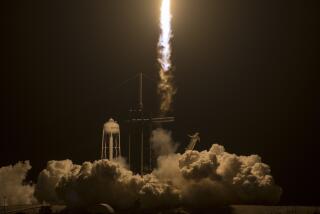Glitch Threatens to Cut Short Shuttle Mission
- Share via
CAPE CANAVERAL, Fla. — The space shuttle Columbia blasted into orbit for the first time in more than two years Friday, and a cooling system problem immediately raised concerns the mission to the Hubble Space Telescope might have to be shortened.
Shuttle program manager Ron Dittemore said he was optimistic that the 11-day mission was on track but said engineers would spend the next 24 hours analyzing the problem in one of two critical coolant loops for the payload bay doors.
If it is considered serious enough, the shuttle may be called back. Dittemore stressed that the seven astronauts were safe and the shuttle’s cooling system was stable.
“This analysis, we firmly believe, will conclude that we are safe to continue the mission for the full duration,” he said. “However, we just need the time to make sure that we dot all the I’s and cross all the T’s to be positive about that conclusion.”
Mission managers will meet again this afternoon to discuss the issue.
Barring a change in schedule, the shuttle and its repair team should catch up to the telescope Sunday. Five grueling days of spacewalking will follow to replace faltering parts and install a new camera that will boost Hubble’s discovery capability tenfold.
With Hubble soaring nearly overhead at an altitude of more than 350 miles, Columbia lifted off before dawn amid the high security that has become typical since Sept. 11. It was a balmy 60 degrees, considerably warmer than the previous morning, when near-freezing temperatures forced a one-day delay.
It was Columbia’s debut following a 2 1/2-year overhaul even more extensive than the one awaiting Hubble. NASA’s oldest shuttle was taken apart, checked for damaged wiring and modernized following its last launch, which was marred by a frightening short-circuit.
Shortly after Columbia arrived in orbit, a reduced flow of Freon was detected in the coolant loop for the radiators on the payload bay’s left door. It appeared the loop was blocked by debris.
A team of engineers formed to investigate the problem determined that the radiators were still dispelling heat from various shuttle systems, and the coolant loop for the right door was working fine.
“It started out looking a little gloomy and it’s looking a lot more optimistic,” Dittemore said.
Astronauts have conducted five spacewalks on previous Hubble repair missions, including the first in 1993 to correct the telescope’s blurred vision. But each of next week’s spacewalks is packed with even more work and every bit of it is critical, making this the most complicated service mission yet.
More to Read
Sign up for Essential California
The most important California stories and recommendations in your inbox every morning.
You may occasionally receive promotional content from the Los Angeles Times.









